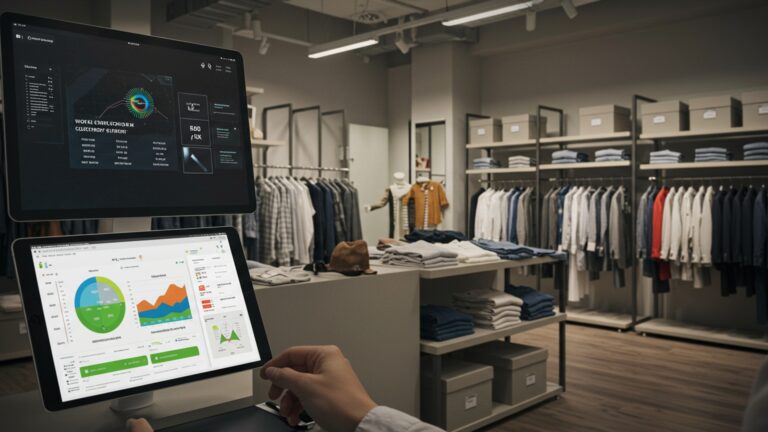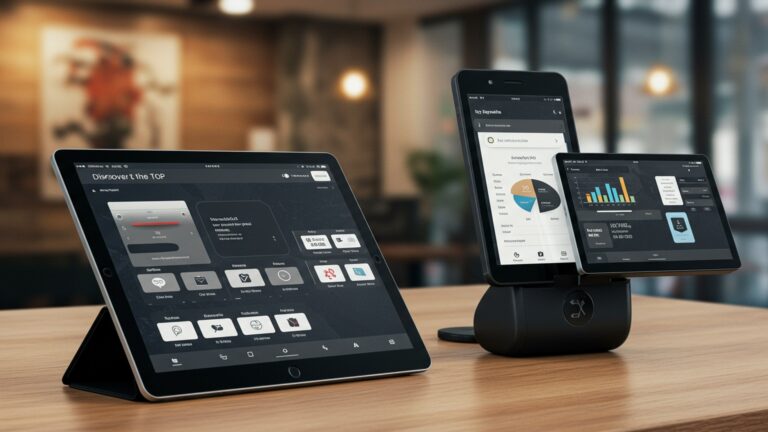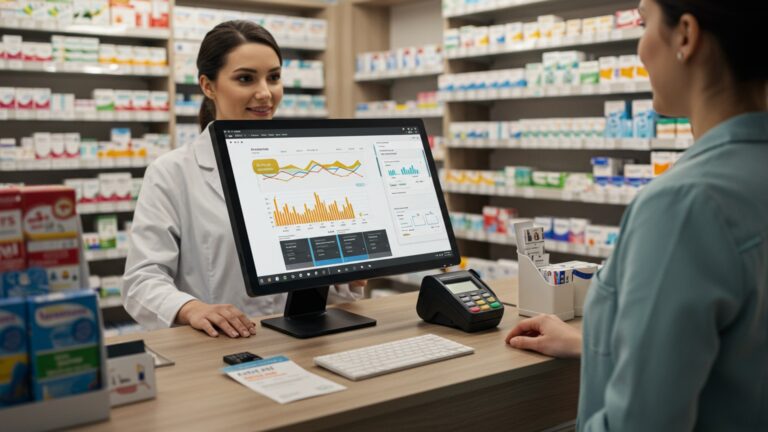Master 8 Key Features Your Restaurant POS System Must Have
In today’s hyper-competitive culinary landscape, a mere cash register simply doesn’t cut it; your restaurant POS software now acts as the central nervous system for operational excellence and profit maximization. Gone are the days of basic order taking, as modern systems, leveraging cloud technology and AI-driven insights, seamlessly integrate everything from dynamic menu management and QR-code ordering to robust inventory tracking and personalized loyalty programs. Restaurants failing to upgrade miss critical opportunities to streamline service, reduce waste. interpret customer behavior in real-time. Mastering the core capabilities of your chosen platform transforms it from a transactional tool into a strategic asset, crucial for navigating complex supply chains and meeting evolving customer expectations.
Streamlined Order Management and Customization
A robust Restaurant POS software begins with its core capability: efficient order management. This isn’t just about punching in orders; it’s about handling the dynamic nature of a busy restaurant environment. A top-tier system allows staff to quickly and accurately take orders, whether dine-in, takeout, or delivery, ensuring that every customer request is captured without delay.
- Intuitive Order Entry: The interface should be user-friendly, allowing new staff to quickly grasp how to navigate menus, select items. process orders. Touchscreen capabilities are standard. a logical layout reduces errors and speeds up service.
- Customization and Modifiers: Restaurants thrive on flexibility. A good system supports extensive item customization, enabling servers to add special requests like “no onions,” “extra cheese,” or “sauce on the side.” This functionality is crucial for customer satisfaction and reducing kitchen errors. For instance, imagine a customer at “The Gourmet Bistro” wanting their pasta dish with gluten-free noodles and an allergen modification; the POS system should allow the server to select these options directly, sending clear instructions to the kitchen.
- Split Orders and Merging: For larger groups or complex dining experiences, the ability to easily split bills by item, seat, or custom amounts, or merge orders, is invaluable. This prevents awkward calculations at the table and streamlines the payment process.
- Hold and Fire Functionality: Especially useful for multi-course meals, this feature allows servers to hold certain items in the queue and “fire” them to the kitchen at the appropriate time, ensuring dishes are prepared fresh and arrive at the table simultaneously.
This foundational element of Restaurant POS software directly impacts service speed and accuracy, which are critical for customer experience.
Comprehensive Table Management and Floor Plans
Effective table management is more than just knowing which tables are occupied; it’s about optimizing your dining room’s flow and maximizing seating capacity. A modern Restaurant POS software provides a visual representation of your restaurant’s layout, empowering hosts and servers to manage tables with precision.
- Interactive Floor Plan: This feature allows staff to see a real-time, graphical representation of the restaurant’s layout. Tables can be color-coded based on their status – e. g. , green for open, red for occupied, yellow for awaiting cleaning, blue for checked out. This visual clarity helps hosts seat guests efficiently and servers monitor their sections.
- Table Status Tracking: Beyond just occupied/open, detailed status tracking can include “seated,” “ordered,” “food served,” “bill requested,” and “paid.” This level of detail helps managers interpret service progression and identify bottlenecks. For example, “Pasta Palace” uses their POS system’s interactive floor plan to see exactly which tables have been waiting for their main course for too long, prompting immediate action.
- Reservation and Waitlist Integration: Seamless integration with reservation systems and digital waitlists allows the POS to not only track current table status but also anticipate future demand. This reduces wait times and improves customer satisfaction by providing accurate estimates. Some systems even offer SMS notifications for guests on the waitlist.
- Server Assignment: Easily assign servers to specific tables or sections. This ensures accountability, streamlines operations. helps track individual server performance, which can be crucial for commission structures or performance reviews.
According to a study published by Cornell University’s School of Hotel Administration, efficient table management can significantly reduce perceived wait times and increase table turns, directly impacting revenue.
Robust Inventory Management
For any restaurant, controlling costs is paramount. a significant portion of those costs comes from ingredients. A powerful Restaurant POS software includes sophisticated inventory management capabilities that move beyond basic stock counts, offering granular control over your kitchen’s larder.
- Ingredient-Level Tracking: This is perhaps the most critical aspect. Instead of just tracking “chicken breasts,” the system should track the quantity of chicken breasts, down to specific units or weight. When a dish like “Chicken Caesar Salad” is sold, the system automatically deducts the precise amount of chicken, lettuce, dressing. croutons used from inventory. This requires initial recipe mapping within the Restaurant POS software.
- Real-time Stock Alerts: Set customizable thresholds for ingredients. When stock levels drop below a certain point, the system automatically generates alerts, prompting managers to reorder. This prevents running out of popular items and ensures menu consistency. For instance, “The Daily Grind” café relies on these alerts to know exactly when to reorder their specialty coffee beans, avoiding any disruption to their morning rush.
- Supplier Management and Purchase Orders: Integrate supplier data directly into the system. Generate purchase orders automatically based on par levels and sales data, streamlining the procurement process and reducing manual errors. Some systems even allow direct electronic ordering with preferred suppliers.
- Waste Tracking: Accurately track spoilage, dropped items, or expired goods. This data is invaluable for identifying areas of waste, adjusting purchasing habits. improving kitchen efficiency. By analyzing waste reports, a restaurant can discover if a particular item consistently spoils before it’s used, leading to better portion control or adjusted ordering quantities.
- Recipe Management: Store and manage all recipes, linking them to menu items. This ensures consistent portioning, helps calculate theoretical food costs. makes training new kitchen staff much easier.
Effective inventory management, powered by advanced Restaurant POS software, can significantly reduce food waste, optimize purchasing. ultimately boost profit margins by minimizing costs. A report by Toast found that restaurants using POS-integrated inventory management can reduce food waste by up to 2-5%.
In-depth Reporting and Analytics
Data is the new gold. a superior Restaurant POS software transforms raw sales figures into actionable insights. Comprehensive reporting and analytics tools are essential for understanding your business performance, identifying trends. making informed strategic decisions.
- Sales Performance Reports: Track sales by hour, day, week, month, or custom date ranges. examine sales by menu item, category, server, or dining area. This helps identify peak hours, popular dishes. underperforming items. For example, “Brew & Bites” uses their sales reports to determine which pastries sell best during the morning rush, adjusting their baking schedule accordingly.
- Labor Cost Analysis: Integrate with employee time clock data to track labor costs against sales. This allows managers to optimize staffing levels, reducing unnecessary overhead during slow periods and ensuring adequate coverage during busy times.
- Menu Item Performance: interpret which dishes are your cash cows and which are menu deadwood. assess profitability per item, not just sales volume. This data can inform menu engineering decisions, helping you refine offerings for maximum profit.
- Void and Discount Reports: Monitor voids, comps. discounts to identify potential training needs, prevent theft. comprehend why items are being discounted. High void rates on certain items might indicate kitchen errors or server mistakes.
- Customer Data Analytics: If integrated with CRM, assess customer purchasing habits, average spend. visit frequency. This informs targeted marketing campaigns and loyalty programs.
These analytical capabilities, often presented through intuitive dashboards, empower restaurant owners and managers to move beyond guesswork and base decisions on hard data, leading to improved operational efficiency and profitability.
Seamless Payment Processing Integration
In today’s diverse payment landscape, a Restaurant POS software must offer flexible and secure payment processing. Customers expect convenience. a system that can handle various payment methods smoothly is no longer a luxury but a necessity.
- Multiple Payment Options: Support for credit/debit cards (Visa, MasterCard, American Express, Discover), mobile payments (Apple Pay, Google Pay), contactless payments (NFC). even digital wallets. The system should also handle cash and gift cards efficiently.
- EMV Compliance: Crucial for security and liability. EMV (Europay, MasterCard. Visa) chip card technology helps prevent fraud by encrypting transaction data. Your POS system must be compatible with EMV readers to protect both your business and your customers.
- Split Payments: As mentioned in order management, the ability to easily split bills among multiple payment methods or individuals is a key convenience feature for diners.
- Offline Mode: In case of internet outages, a reliable Restaurant POS software should have an offline mode that allows transactions to be processed and stored locally, syncing them once connectivity is restored. This prevents service disruption and lost sales.
- Integrated vs. Standalone: While standalone terminals work, integrated payment processing directly with your POS system offers greater efficiency, fewer errors. centralized reporting. An integrated system automatically sends transaction details to the payment processor, eliminating manual entry and reconciliation headaches.
According to a report by Statista, contactless payments are projected to grow significantly, underscoring the importance of a POS system that supports these modern transaction methods. A restaurant that offers diverse, secure payment options enhances customer satisfaction and streamlines the checkout process.
Efficient Employee Management
Your staff are the backbone of your restaurant. a comprehensive Restaurant POS software can significantly streamline their management, from scheduling to performance tracking.
- Time Clock Functionality: Allow employees to clock in and out directly from the POS terminal. This ensures accurate timekeeping, simplifies payroll processing. helps track labor costs in real-time. Features like biometric login or PINs can enhance accuracy.
- Role-Based Permissions: Assign different access levels and permissions based on job roles. For example, a server might be able to process orders and take payments, while a manager has access to void transactions, run reports. make inventory adjustments. This prevents unauthorized actions and maintains system integrity.
- Performance Tracking: Monitor individual server sales, average check size. tip reporting. This data can be invaluable for performance reviews, identifying top performers. pinpointing areas where staff might need additional training. For instance, “The Urban Eatery” uses this feature to incentivize their servers with bonuses based on their average upsell rates.
- Scheduling Integration: While some POS systems offer basic scheduling, many integrate with dedicated scheduling software. This allows managers to create schedules, manage shift swaps. communicate with staff seamlessly, reducing conflicts and ensuring adequate staffing.
- Tip Management: Facilitate accurate tip declarations and distribution, especially essential for pooled tips or when dealing with various payment methods.
By centralizing employee data and operational tools within the Restaurant POS software, managers can dedicate more time to guest experience and less to administrative tasks, fostering a more productive and compliant work environment.
Customer Relationship Management (CRM) and Loyalty Programs
Building a loyal customer base is key to long-term success. A modern Restaurant POS software extends its capabilities to help you comprehend and engage with your customers, turning first-time visitors into regulars.
- Customer Database: Create detailed customer profiles, including contact data, visit history, preferred orders. any dietary restrictions. This data helps personalize service and marketing efforts. For example, if a regular at “Café Delight” always orders a vegan latte, the system can prompt the server with this preference.
- Integrated Loyalty Programs: Implement point-based systems, tiered rewards, or punch cards directly through the POS. Customers can earn points with each purchase, redeem them for discounts or free items. receive personalized offers. This encourages repeat business. A study by Bond Brand Loyalty found that 77% of consumers say loyalty programs make them more likely to continue doing business with brands.
- Personalized Marketing: Leverage customer data to send targeted email or SMS campaigns. Announce new menu items, special promotions, or birthday offers to specific segments of your customer base. This direct engagement significantly increases campaign effectiveness compared to generic advertising.
- Feedback Collection: Some systems allow for direct customer feedback collection at the point of sale or via integrated surveys, providing valuable insights into guest satisfaction and areas for improvement.
By investing in a Restaurant POS software with robust CRM and loyalty features, restaurants can foster stronger customer relationships, drive repeat business. gain a competitive edge in a crowded market.
Seamless Kitchen Display System (KDS) Integration
The kitchen is the heart of your restaurant. efficient communication between the front-of-house (FOH) and back-of-house (BOH) is vital. A Kitchen Display System (KDS) integrated with your Restaurant POS software replaces traditional paper tickets, revolutionizing kitchen operations.
- Digital Order Display: Orders entered at the POS instantly appear on screens in the kitchen. These displays can be organized by station (e. g. , grill, sauté, prep), ensuring each cook sees only the items relevant to their role. This eliminates handwritten ticket errors and improves legibility.
- Real-time Order Tracking: Cooks can mark items or entire orders as “prepared,” “cooking,” or “completed.” This real-time status update is visible to the FOH staff, allowing them to provide accurate updates to diners and coordinate dish delivery. Imagine “The Seafood Shack” using their KDS to ensure that a table’s appetizers, main courses. desserts are perfectly timed, improving guest experience.
- Order Aggregation and Prioritization: The KDS can aggregate similar items from different orders, helping cooks batch prepare ingredients. It can also prioritize orders based on table number, course, or estimated prep time, optimizing kitchen workflow during peak hours.
- Reduced Errors and Waste: Clear digital displays drastically reduce misread orders and communication breakdowns, leading to fewer remakes and less food waste.
- Analytics on Kitchen Performance: Some advanced KDS systems provide data on prep times for different dishes, peak kitchen load. average ticket times. This data is invaluable for optimizing kitchen layout, staffing. menu design.
// Example of a simplified KDS order object structure
{ "orderId": "ORD-20230315-001", "tableNumber": 12, "items": [ { "itemId": "SKU001", "itemName": "Grilled Salmon", "modifiers": ["No Asparagus", "Extra Lemon"], "station": "Grill", "status": "Cooking" }, { "itemId": "SKU005", "itemName": "Caesar Salad", "modifiers": [], "station": "Prep", "status": "Prepared" } ], "orderType": "Dine-in", "timestamp": "2023-03-15T19:30:00Z", "priority": "Normal"
}
A seamlessly integrated KDS is a game-changer for kitchen efficiency, speed. accuracy, directly impacting guest satisfaction and operational smoothness. It’s a prime example of how modern Restaurant POS software optimizes the entire dining experience.
Conclusion
Selecting the right POS system transcends merely checking off features; it’s a strategic investment in your restaurant’s future resilience and efficiency. I’ve personally seen the chaos a poorly chosen system can unleash, like a busy Saturday night brought to a standstill because the old setup couldn’t handle integrated online orders. That’s why crucial functionalities, from seamless inventory management to robust analytics and contactless payment options that reflect current consumer trends, are non-negotiable. My personal tip: beyond the demo, always ask to speak with a current user in a similar restaurant environment. Their real-world experience offers invaluable insights a sales pitch can’t replicate. Remember to prioritize cloud-based solutions for accessibility and scalability, as the industry rapidly embraces ‘anywhere, anytime’ management. Embracing a modern POS isn’t just about operations; it’s about empowering your team and delighting your guests, propelling your establishment towards sustained success and growth. For deeper dives into emerging tech, consider resources like Restaurant Technology News.
More Articles
Optimizing Your Restaurant’s Inventory Management
Strategies to Boost Your Restaurant’s Online Orders
The Future of Contactless Payments in Hospitality
Streamlining Staff Management with Your POS System
Leveraging Data Analytics for Restaurant Profitability
FAQs
Why is efficient order and table management so crucial for a restaurant POS?
It’s a game-changer for speed and accuracy! A top-notch POS lets your staff quickly take orders, send them straight to the kitchen. easily manage table statuses. This cuts down on mistakes, speeds up service. ultimately makes your customers much happier.
Can a modern POS really help me keep track of all my inventory?
Absolutely! A strong POS system includes robust inventory management. It monitors your stock levels for ingredients and menu items, alerts you when things are running low. helps you avoid waste, ensuring you never run out of popular dishes unexpectedly.
What payment options should I expect from a good restaurant POS system?
You should look for a system that’s super flexible! This means supporting credit/debit cards, mobile payments like Apple Pay, gift cards. even making it easy to split bills. The more convenient payment options you offer, the better experience your guests will have.
How does a POS system provide insights into my restaurant’s performance?
Think of it as your built-in business analyst! A good POS system generates detailed reports on sales trends, popular menu items, peak hours. even individual employee performance. These insights are invaluable for making smart decisions about your menu, staffing. marketing strategies.
Does a POS system make managing my restaurant staff any easier?
Yes, it totally can! Many POS systems come with employee management features that let you track shifts, manage time clocks, assign roles. even monitor individual sales. This simplifies payroll, helps you optimize scheduling. boosts overall team efficiency.
Can a restaurant POS help me build stronger relationships with my customers?
Definitely! Some systems include Customer Relationship Management (CRM) features that allow you to collect customer data, track their order history. manage loyalty programs. This helps you personalize their experience, offer targeted promotions. build a loyal base of returning patrons.
What about online orders and food delivery? Can a POS handle that seamlessly?
A great POS system integrates smoothly with various online ordering platforms, whether it’s your own website or third-party delivery services. It consolidates all orders into one place, making it incredibly easy for your kitchen and staff to manage everything efficiently without juggling multiple tablets.
What’s a KDS. why should my POS system be connected to one?
A KDS, or Kitchen Display System, replaces old-school paper tickets with digital screens in the kitchen. When your POS integrates with a KDS, orders from the front of the house immediately pop up on these screens, reducing errors, speeding up prep times. making communication crystal clear. It’s a huge boost for kitchen efficiency!





